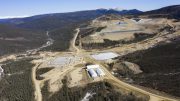In the letter from Stu Averill that you published in your July 18-24, 2011 issue, he raised several issues of wider interest than just the results published by Trelawney Mining and Exploration that he addressed. I draw your attention to some of these issues in the following comments.
Just how to treat what appear to be exotic high-grade assays of precious metals in reserve estimations has been the subject of animated discussions in our industry for a long time. Averill makes it clear that the question is yet to be resolved. “Cutting” – or to use the suddenly more fashionable “topping” – is the easy and long-practiced way out of the predicament. It is easy to do and understand, but has no rational basis beyond the wish to demonstrate caution.
For the average of any group of numbers to justify manipulation and to have any meaning, it is essential that they be distributed “normally.” Gold assays can often be cast into this form by treating their logarithms to obtain the familiar “log-normal” distribution. Some recent authors of National Instrument 43-101 compliant reports simply state that the “assay results appear to be log-normally distributed,” before proceeding to apply a lot of convoluted geostatistics.
In the report by Roscoe Postle Associates referred to by Averill, the authors present a clear graph showing the assays plotted on a cumulative log-normal scale. For the assays to follow the log-normal rule, the results should plot as a straight line.
In this example, the line has a slight upward bow for which two interpretations are possible. The first is that there are two distinct distributions of gold values, the other is that there is a single distribution that can be adjusted to fit a straight line by adding a constant to each assay (the so-called three-parameter log-normal distribution).
The first case is difficult to untangle, but the second is easy and relieves the estimator of the “cut-off” decision. It is easy to do, and might be worth trying in this example. Deviation from a straight line of the curve of the cumulative log-normal plot can also suggest sampling problems. We all know that “figures don’t lie,” but it is sometimes hard to understand their complete message.
Rather than “cut” a high assay, some resource estimators choose to constrain the influence of a high value by reducing its area
of influence. One trick is to use “inverse distance cubed” instead of the square. Again, this is easy to do, but it is difficult to justify logically.
With good reason, Averill deprecates the common, current practice of companies which report assays from drill holes in the form: “100 metres averaging 1 gram, in which 20 metres average 2 grams, in which 5 metres average 10 grams.” Even if he or she knows how, I suggest the average “prudent investor” is seldom motivated to work out the content of the low-grade portions of such an intersection. This type of reporting verges on being deceptive, but it is widely used. One set of results reported in this way by one company and published in your newspaper in January, suggested to me that the low-grade material contained “negative gold.”
It is all too easy to key-in a pile of assay results into a computer program that claims to calculate (which means “estimate”) reserves.
I feel our industry in general is becoming bemused by what computers offer. We must keep an eye on what the rocks tell us in the form of geological information, and use statistical tools wisely.
There is a pressing need in our industry, which perhaps the Canadian Institute of Mining, Metallurgy and Petroleum might resolve, for a volume of case studies comparing the reserve position at the time a production decision was made with the ultimate result.
Success has its own rewards. But can we interpret evidence any better to predict failure, or at least wave cautionary flags?
Brian Hester
Vineland, Ont.


Be the first to comment on "Letter to the editor: Treating high-grade gold assays"